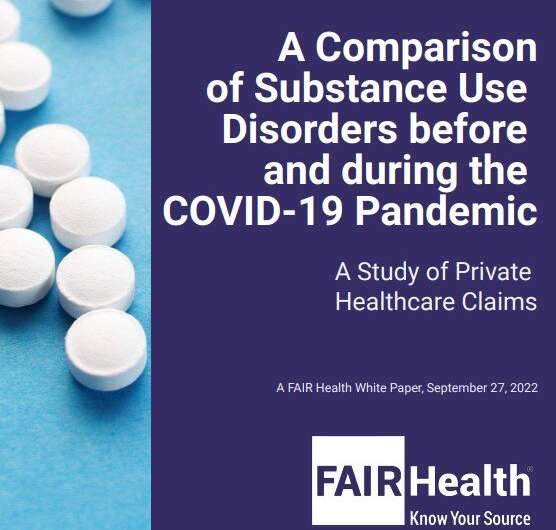Credit: FAIR Health
In every year of the period 2016–2021, males accounted for 62 to 63% of the gender distribution of patients with a substance use disorder diagnosis, while females made up 37 to 38%, according to a new white paper from FAIR Health. In every year of the same period, females accounted for 60 to 61% of the gender distribution of patients with an overdose diagnosis, while males made up 39 to 40%. The white paper, released today, is titled "A Comparison of Substance Use Disorders before and during the COVID-19 Pandemic: A Study of Private Healthcare Claims."
In this report, drawing on the nation's largest repository of private health care claims, FAIR Health analyzes substance use disorders and overdoses prior to the COVID-19 pandemic as compared to during the pandemic. Trends in the percentage of patients with a substance use disorder or overdose diagnosis are analyzed, as well as such aspects as age, gender, incidence, relevant substances, states, preexisting mental health conditions, venues of care and provider specialties.
Among the key findings:
- From 2019 to 2021, 42 states saw an increase in the proportion of patients with opioid and opioid-like drug overdoses compared to the total number of patients using medical services by state. The increases ranged from 148.4% in Pennsylvania to 0.7% in Minnesota.
- During the pandemic, the percentage of patients with a substance use disorder diagnosis decreased by 4.4%, from 3.5% of all patients in 2019 (pre-pandemic) to 3.4% in 2021 (during the pandemic). But in one age group, those 65 and older, the percentage of patients with a substance use disorder diagnosis increased 5.3%, from 3.3% of all patients in that age group in 2019 to 3.5% in 2021.
- The percentage of patients with an overdose diagnosis increased 4.3%, from 0.56% of all patients in 2019 to 0.59% in 2021.
- Alcohol and opioids were the top two substances associated with substance use disorders throughout the 2019–2021 time frame. Substance use disorders involving alcohol, however, increased over that period from 47% to 52% of the distribution, while opioids fell from 25% of the distribution to 21%.
- From 2016 to 2021, the share of patients with substance use disorders involving the use of stimulants (e.g., amphetamines, methamphetamines) rose 36.4%, from 0.046% of all patients to 0.063%; this percentage increase exceeded those of alcohol, opioids and cannabis.
- In 2021, the percentage of patients with an initial diagnosis of substance use disorder or overdose increased month over month compared to the two prior years.
- In 2019 and 2021, New Mexico was the state with the highest proportion of patients with a substance use disorder or overdose diagnosis.
- From 2019 to 2021, Nebraska was the state with the greatest increase in the proportion of patients with a substance use disorder diagnosis. Maryland was the state with the greatest increase in the proportion of patients with an overdose diagnosis.
- Sixty-five percent of patients who had a substance use disorder or overdose diagnosis in 2021 had a preexisting mental health condition. Generalized anxiety disorder and major depressive disorder, in that order, were the two most common mental health diagnoses in this population in 2021.
- The percentage of substance use disorder services rendered via telehealth rose from 0.3% in 2019 to 11.3% in 2020, then dropped to 9.3% in 2021.
- Psychiatrists' share of substance use disorder claim lines increased 112.4%, from 3.9% in 2016 to 8.3% in 2021.
FAIR Health President Robin Gelburd stated, "During the COVID-19 pandemic, substance use disorders and overdoses proved to be a significant public health issue. We hope our study of this issue offers helpful insights for patients, providers, payors, policy makers and researchers."
More information: A Comparison of Substance Use Disorders before and during the COVID-19 Pandemic: A Study of Private Healthcare Claims
Provided by FAIR Health
























